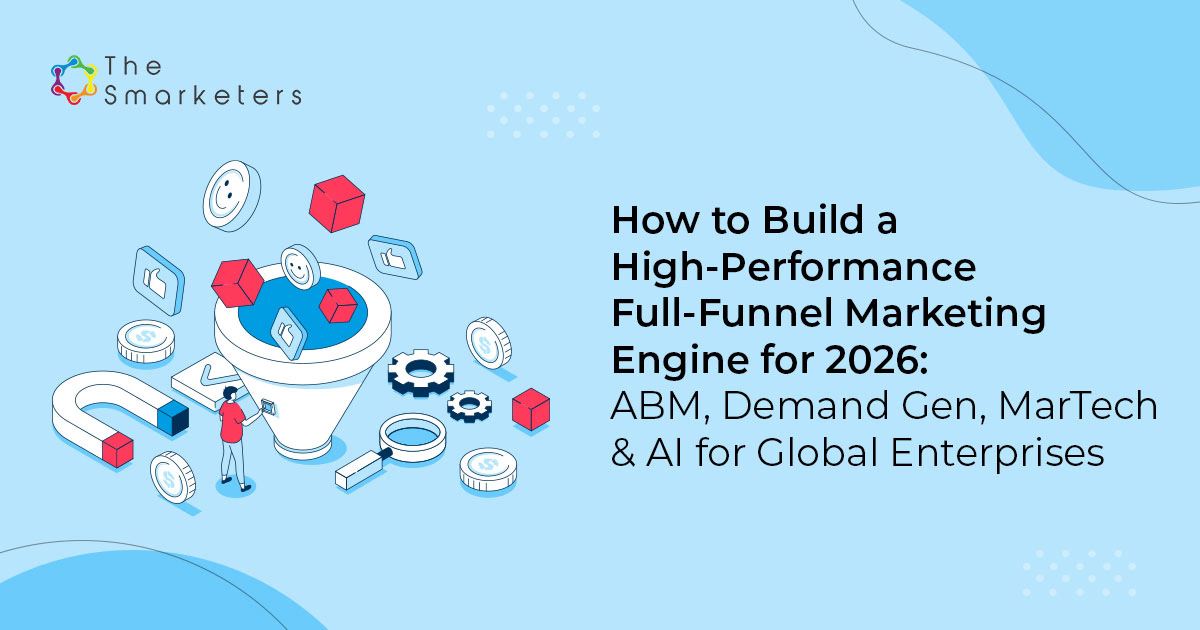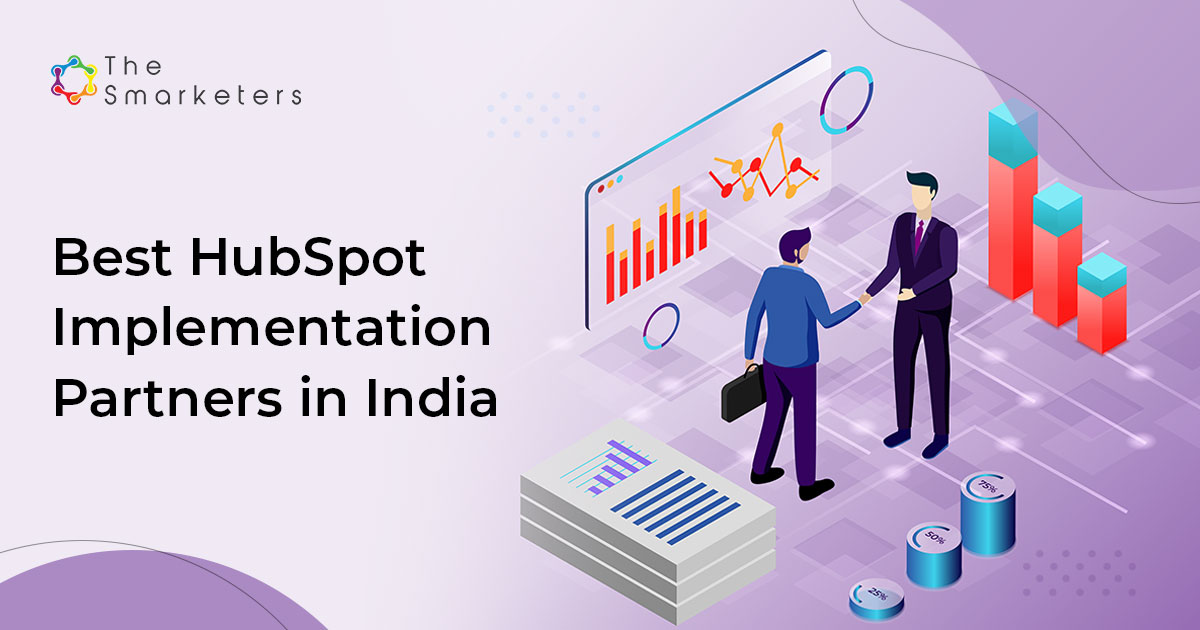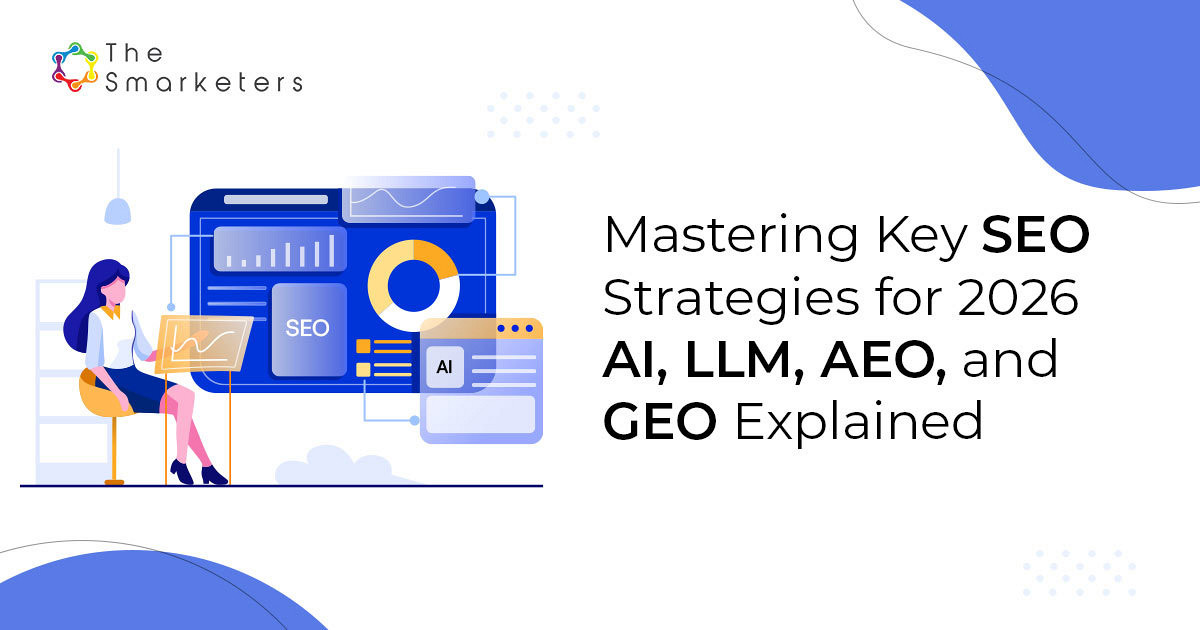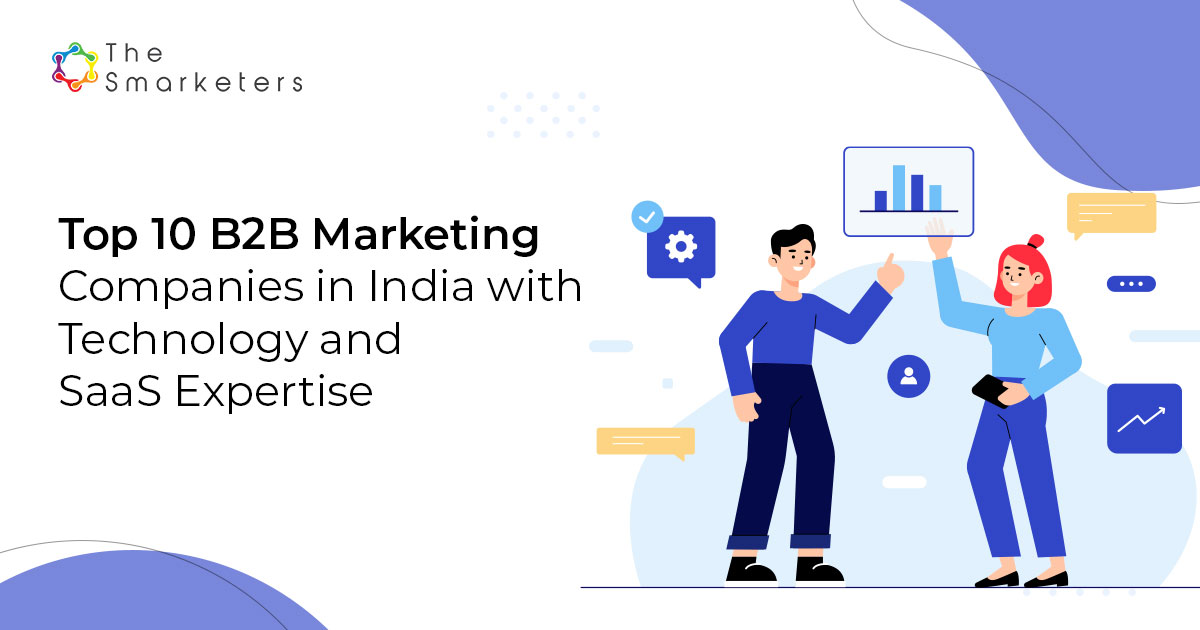Table of Contents
- Understanding Generative Engine Optimization (GEO)
- Conducting Generative AI Research and Analysis
- Optimizing Content for Generative AI
- Technical Optimization for AI Accessibility
- Enhancing Content Distribution and Engagement
- How Can B2B Companies leverage GenEO for improved visibility
- Building Brand Authority and Credibility
- FAQs
- Winning Inbound Marketing Tactics for 2026: AI, Hyper-personalization, and Beyond
- Boost Your AI Visibility: How to Get Discovered on ChatGPT, Claude, and Perplexity
- Mastering Key SEO Strategies for 2026: AI, LLM, AEO, and GEO Explained
- Top 10 B2B Marketing Companies in India with Technology and SaaS Expertise
- Top 10 ABM Companies in India: Your Complete Guide to Finding the Right Partner in 2026
In the age of AI-driven search, is your B2B company’s online presence future-proof? 🤖
As generative AI reshapes the digital landscape, traditional SEO strategies are no longer enough to ensure visibility and engagement. Enter Generative Engine Optimization (GEO) – the evolution of SEO that’s revolutionizing how B2B companies connect with their audience. But here’s the challenge: many businesses are still struggling to adapt, risking obsolescence in an increasingly AI-dominated market.
Don’t let your brand fade into the digital background. This comprehensive guide will walk you through the essential strategies of GEO, from conducting AI-focused research to building unshakeable brand authority. Whether you’re looking to optimize your content for AI algorithms, enhance your technical accessibility, or supercharge your distribution efforts, we’ve got you covered. Ready to future-proof your B2B company’s online presence? Let’s dive into the world of Generative Engine Optimization and unlock the power of AI-driven visibility. 🚀
Understanding Generative Engine Optimization (GEO)
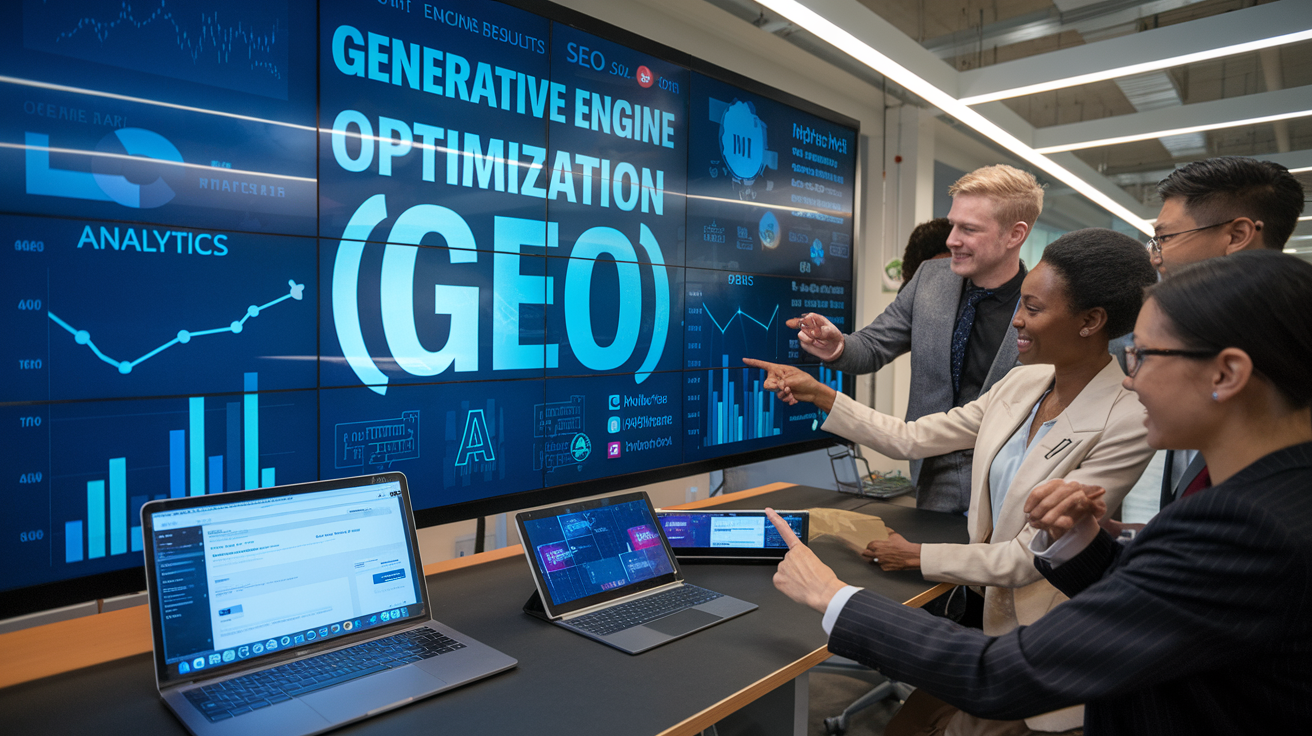
A. Definition and importance of GEO for B2B companies
Generative Engine Optimization (GEO) represents a paradigm shift in digital marketing, particularly for B2B companies. It’s an innovative approach that leverages AI-driven search capabilities to enhance lead generation strategies. Unlike traditional SEO methods that rely on fixed keyword strategies, GEO employs a dynamic model that utilizes AI to generate, optimize, and adapt digital content in real-time.
The importance of GEO for B2B companies cannot be overstated:
- Personalized content creation
- Improved lead quality and conversion rates
- Enhanced efficiency and cost-effectiveness
- Adaptation to evolving search behaviors
- Competitive edge in the digital landscape
By implementing GEO, B2B companies can focus more on strategic planning rather than the minutiae of content generation, resulting in greater overall marketing effectiveness.
B. How GEO differs from traditional SEO
While traditional SEO and GEO share the common goal of improving visibility, they differ significantly in their approaches and focus areas:
| Aspect | Traditional SEO | Generative Engine Optimization (GEO) |
|---|---|---|
| Focus | Keyword ranking and backlink accumulation | AI-driven search environments and user intent |
| Content Strategy | Fixed keyword-based content | Dynamic, AI-generated and adapted content |
| User Behavior | Multiple search result pages | Direct, synthesized answers |
| Optimization Target | Conventional search engines | AI platforms (e.g., ChatGPT, Google Gemini) |
| Content Types | Primarily text-based | Diverse formats (listicles, FAQs, multimedia) |
| Update Frequency | Periodic updates | Continuous, real-time adaptations |
GEO requires a more holistic approach, emphasizing machine readability, contextual richness, and alignment with user intent throughout the buying journey.
C. The impact of AI algorithms on content strategies
AI algorithms are fundamentally altering B2B decision-making processes and, consequently, content strategies. The impact is multifaceted:
- Shift in search behavior: Users now prefer direct, synthesized answers over sifting through multiple search results.
- Content personalization: AI enables highly targeted content creation that resonates with specific audience segments.
- Real-time adaptability: Content strategies must be flexible to accommodate rapid changes in user behavior and industry trends.
- Expanded content formats: AI-driven platforms encourage diverse content types, including listicles, FAQs, and multimedia content.
- Enhanced data analysis: AI algorithms provide deeper insights into user interactions, allowing for more informed content decisions.
To thrive in this AI-centric marketplace, B2B companies must adapt their content strategies to ensure accurate representation and maintain relevance in these evolving digital environments.
With this understanding of GEO and its impact on B2B content strategies, we’ll next explore the crucial process of “Conducting Generative AI Research and Analysis.” This step is essential for developing effective GEO strategies that align with the latest AI advancements and user behaviors.
Conducting Generative AI Research and Analysis

Now that we have explored the concept of Generative Engine Optimization (GEO) and its importance for B2B companies, let’s delve into the crucial process of conducting generative AI research and analysis. This step forms the foundation for effective GEO strategies, enabling businesses to optimize their content for AI-driven search engines and improve their online visibility.
A. GEO keyword research techniques
GEO keyword research differs from traditional SEO approaches by focusing on intent-based searches and contextual relevance. To conduct effective GEO keyword research:
- Utilize advanced tools like SEMRush and Ahrefs for comprehensive keyword mapping
- Focus on long-tail and semantic keywords that align with user intent
- Identify phrases that resonate with users and AI algorithms alike
- Incorporate location-specific terms for improved local search performance
| Traditional SEO Keywords | GEO-Focused Keywords |
|---|---|
| “B2B content marketing” | “AI-optimized B2B content strategies” |
| “SEO for businesses” | “Generative AI research for B2B visibility” |
| “Online brand presence” | “Building brand authority in AI-driven search” |
B. Analyzing AI Overview responses for brand representation
To ensure your brand is accurately represented in AI-generated search results:
- Monitor AI Overview responses for your brand and key topics
- Identify gaps or misrepresentations in AI-generated content
- Adjust your content strategy to address these issues and improve accuracy
- Focus on creating comprehensive, contextually rich content that aligns with E-E-A-T principles
C. Competitor research in the context of GEO
Analyzing competitors’ GEO strategies can provide valuable insights:
- Examine how competitors’ content performs in AI-driven search results
- Identify successful GEO techniques employed by industry leaders
- Assess competitors’ use of structured data and technical optimization
- Analyze their content distribution and engagement strategies across multiple platforms
By conducting thorough competitor research, you can refine your own GEO strategies and identify opportunities for differentiation in the AI-driven search landscape.
To effectively implement these research and analysis techniques, consider the following best practices:
- Maintain consistency in your NAP (Name, Address, Phone) information across all platforms
- Leverage local business schema markup to enhance AI understanding of your business
- Use tools like BrightLocal for local SEO insights and performance tracking
- Regularly update your content to ensure freshness and relevance for AI algorithms
By mastering these research and analysis techniques, B2B companies can lay a solid foundation for their GEO efforts. This approach will help ensure that your content is not only discoverable but also contextually relevant and authoritative in the eyes of AI-driven search engines.
With this comprehensive understanding of generative AI research and analysis, we can now move on to the next crucial step: optimizing content for generative AI. This process will involve creating high-quality, structured content that aligns with the insights gained from our research efforts.
Optimizing Content for Generative AI

Now that we have conducted thorough generative AI research and analysis, it’s time to focus on optimizing our content for these advanced systems. By implementing the following strategies, B2B companies can ensure their content is primed for generative AI consumption and distribution.
Creating high-quality, contextually rich content
To optimize content for generative AI, it’s crucial to prioritize semantic clarity and contextual richness. AI systems, unlike traditional search engines, rely heavily on understanding the overall context and meaning of content. Here are key strategies to implement:
- Use unique and meaningful titles that accurately reflect the content
- Provide comprehensive coverage of topics
- Adopt a conversational tone to enhance readability
- Employ clear, active language for better AI comprehension
By focusing on these elements, your content becomes more accessible to AI systems, increasing the likelihood of it being accurately interpreted and distributed to your target audience.
Incorporating long-tail and semantic keywords
While traditional SEO emphasizes specific keywords, generative AI optimization requires a more nuanced approach:
- Balance keywords with natural language
- Focus on topical authority rather than keyword density
- Integrate semantic keywords that relate to the main topic
This approach helps AI systems understand the context and relevance of your content within your industry niche. Here’s a comparison of traditional keyword usage versus semantic keyword integration:
| Traditional Keyword Approach | Semantic Keyword Integration |
|---|---|
| Repetitive use of exact-match keywords | Use of related terms and concepts |
| Focus on keyword density | Emphasis on contextual relevance |
| Limited variation in phrasing | Natural language variations |
| Potential for keyword stuffing | Organic incorporation of keywords |
Ensuring content freshness and variety
To maintain visibility in AI-generated responses, it’s essential to keep your content fresh and diverse:
- Regularly update existing content based on:
- Strategic importance
- User engagement metrics
- Evolving industry standards
- Create journey-specific content tailored to different user stages
- Develop strong FAQs to address common queries
- Integrate multiple content formats (e.g., text, images, videos)
By consistently refreshing your content and offering a variety of formats, you increase the chances of your B2B company being included in AI training datasets and appearing in AI-generated responses.
Remember to build topical authority by securing mentions in high-authority publications within your industry. This strategy enhances your visibility in AI-generated content and establishes your brand as a credible source of information.
As we move forward, it’s important to consider the technical aspects of AI accessibility. In the next section, we’ll explore how B2B companies can optimize their websites and content structures to ensure seamless interaction with AI crawlers and systems, further enhancing their generative engine optimization efforts.
Technical Optimization for AI Accessibility

Now that we’ve covered optimizing content for generative AI, let’s delve into the technical aspects of making your website more accessible to AI systems. This technical optimization is crucial for ensuring that AI can effectively crawl, understand, and rank your content.
Implementing structured data
Structured data plays a vital role in helping AI systems understand the context and relationships within your content. By implementing structured data markup, you can:
- Enhance your website’s visibility in AI-driven search results
- Improve indexing and comprehension by AI crawlers
- Provide clear context for AI platforms like ChatGPT and Claude
To effectively implement structured data:
- Use schema.org vocabulary
- Focus on relevant entity types for your B2B content
- Ensure consistency across your website
- Regularly validate your structured data implementation
Improving site speed and mobile-friendliness
AI systems prioritize fast-loading and mobile-friendly websites. To optimize for these factors:
- Compress images and minify code
- Leverage browser caching
- Implement lazy loading for images and videos
- Use responsive design principles
Here’s a comparison of site speed optimization techniques:
| Technique | Impact on Speed | Ease of Implementation |
|---|---|---|
| Image compression | High | Easy |
| Code minification | Medium | Moderate |
| Browser caching | High | Moderate |
| Lazy loading | Medium | Easy |
Maintaining secure site practices
Security is a crucial aspect of technical optimization for AI accessibility. AI systems favor websites that demonstrate robust security measures. To maintain secure site practices:
- Use HTTPS protocol across your entire website
- Implement regular security audits
- Keep all software and plugins up-to-date
- Use strong authentication methods
By focusing on these technical optimizations, you can significantly improve your website’s accessibility to AI systems. This, in turn, enhances your visibility in AI-driven search results and improves overall performance in generative engine optimization.
As we move forward, we’ll explore how to enhance content distribution and engagement, building upon the solid technical foundation we’ve established. This next section will delve into strategies for effectively disseminating your AI-optimized content and maximizing user engagement across various platforms.
Enhancing Content Distribution and Engagement

Now that we’ve covered the technical aspects of optimizing content for AI accessibility, let’s delve into enhancing content distribution and engagement, which is crucial for maximizing the impact of your Generative Engine Optimization (GEO) efforts.
A. Identifying relevant platforms for content distribution
When it comes to content distribution, it’s essential to leverage a mix of owned, earned, and paid media channels. This approach ensures maximum reach and effectiveness in a competitive landscape. To identify the most relevant platforms:
- Analyze your audience’s preferences and behaviors
- Create detailed personas to guide channel selection
- Evaluate platform-specific metrics to determine effectiveness
| Channel Type | Examples | Benefits |
|---|---|---|
| Owned | Website, social media profiles | Direct control, cost-effective |
| Earned | Shares, mentions, reviews | Organic reach, credibility |
| Paid | Advertising, sponsored content | Targeted exposure, scalability |
AI-powered tools can significantly enhance your platform selection process by:
- Analyzing user data to identify optimal distribution channels
- Providing insights into audience engagement patterns
- Optimizing content for specific platforms through automated A/B testing
B. Encouraging user-generated content
User-generated content (UGC) is a powerful way to boost engagement and credibility. To encourage UGC:
- Create interactive campaigns that prompt user participation
- Leverage social media platforms to host contests or challenges
- Showcase and reward user contributions to incentivize further engagement
AI can play a crucial role in managing and leveraging UGC by:
- Automating content curation based on user preferences
- Analyzing sentiment in user-generated materials
- Identifying trending topics and themes within UGC
C. Leveraging social media for audience engagement
Social media platforms offer unique opportunities for B2B companies to engage their audience and distribute content effectively. To maximize social media engagement:
- Utilize AI-driven tools to optimize posting times
- Personalize content for different audience segments
- Monitor brand perception through sentiment analysis
AI-powered strategies for social media engagement include:
- Content repurposing: Transform existing content into various formats (e.g., carousels, infographics) for multiple promotions
- Predictive analytics: Forecast user preferences and identify effective distribution channels
- Automated content recommendations: Suggest relevant content based on user behavior and interests
By implementing these strategies, B2B companies can significantly enhance their content distribution and engagement efforts. However, it’s crucial to maintain a balance between AI-driven automation and human oversight to ensure authenticity and genuine connection with the audience.
As we move forward, we’ll explore how B2B companies can leverage GEO for improved visibility, building upon the foundation of effective content distribution and engagement strategies we’ve discussed here.
How Can B2B Companies leverage GenEO for improved visibility

Identifying Key Opportunities for GenEO Implementation
B2B companies can leverage Generative Engine Optimization (GenEO) to significantly improve their visibility in the digital landscape. By focusing on specific areas where GenEO can make the most impact, businesses can enhance their online presence and attract more potential clients.
Target Industry-Specific AI-Generated Content
One of the most effective ways B2B companies can utilize GenEO is by creating highly targeted, industry-specific content. This approach involves:
- Analyzing competitor content
- Identifying knowledge gaps in the industry
- Generating comprehensive, AI-optimized articles
- Tailoring content to address specific pain points of potential clients
By implementing these strategies, B2B companies can position themselves as thought leaders in their respective industries, improving their visibility and credibility.
Optimize Product Descriptions and Service Pages
GenEO can be particularly powerful when applied to product descriptions and service pages. Here’s how B2B companies can leverage this:
| Strategy | Benefits |
|---|---|
| Use AI to generate detailed, keyword-rich descriptions | Improved search engine rankings |
| Incorporate industry-specific terminology | Enhanced relevance for target audience |
| Create dynamic content that adapts to user behavior | Increased engagement and conversions |
| Implement structured data markup | Better visibility in rich snippets |
Leveraging AI-Driven Content Creation for Thought Leadership
B2B companies can establish themselves as industry leaders by consistently producing high-quality, AI-optimized content. This can include:
- Whitepapers
- Case studies
- Industry reports
- Expert interviews
By using GenEO to create and optimize this content, B2B companies can ensure that their thought leadership pieces are not only informative but also highly visible to their target audience.
Enhancing Technical Documentation and Support Materials
GenEO can be particularly valuable for B2B companies that offer complex products or services. By optimizing technical documentation and support materials, businesses can:
- Improve customer satisfaction
- Reduce support ticket volume
- Enhance product understanding
- Increase user adoption rates
This approach not only improves visibility but also demonstrates the company’s commitment to customer success.
Implementing AI-Powered Chatbots and Virtual Assistants
B2B companies can significantly improve their visibility and customer engagement by implementing AI-powered chatbots and virtual assistants. These tools can:
- Provide instant responses to customer queries
- Offer personalized product recommendations
- Guide users through complex processes
- Collect valuable data for further optimization
By leveraging GenEO in the development of these AI-powered tools, B2B companies can ensure that their virtual assistants are not only helpful but also optimized for visibility in search results.
Now that we’ve explored how B2B companies can leverage GenEO for improved visibility, let’s delve into the crucial aspect of building brand authority and credibility in the AI-driven landscape.
Building Brand Authority and Credibility

Now that we have explored how B2B companies can leverage GenEO for improved visibility, let’s delve into the crucial aspect of building brand authority and credibility in the context of Generative Engine Optimization.
A. Obtaining backlinks from authoritative sites
Establishing trust and credibility in an AI-driven landscape requires a strategic approach to link-building. Here are some key strategies for obtaining high-quality backlinks:
- Create valuable, original content that other sites want to reference
- Engage in guest posting on reputable industry blogs
- Participate in industry events and conferences to build relationships
- Collaborate with influencers and thought leaders in your niche
- Utilize digital PR tactics to gain mentions from authoritative news outlets
| Backlink Source | Benefits |
|---|---|
| Industry Publications | Enhances domain authority and expertise |
| Academic Institutions | Boosts credibility and trustworthiness |
| Government Websites | Demonstrates compliance and reliability |
| Reputable News Outlets | Increases brand visibility and authority |
B. Maintaining transparency in content creation
Transparency is crucial for building trust with both users and AI algorithms. To maintain transparency:
- Clearly disclose any use of AI-generated content
- Provide sources and references for data and statistics
- Be open about your content creation process
- Regularly update and fact-check your content
- Encourage user feedback and address concerns promptly
C. Showcasing expertise through original research and collaborations
Demonstrating deep industry knowledge and expertise is essential for building brand authority. Here’s how to showcase your expertise:
- Conduct and publish original research studies
- Create comprehensive whitepapers and in-depth guides
- Host webinars and online workshops featuring industry experts
- Collaborate with academic institutions on relevant projects
- Contribute to industry standards and best practices
Implementing these strategies will not only enhance your brand’s authority but also improve your visibility in AI-generated content. By focusing on high-quality backlinks, maintaining transparency, and showcasing expertise, B2B companies can establish themselves as trusted sources of information in their respective industries.
Remember that building brand authority and credibility is an ongoing process that requires consistent effort and adaptation to evolving AI algorithms. As you implement these strategies, continuously monitor your brand’s performance and adjust your approach based on the results.
With this solid foundation of brand authority and credibility, you’ll be better positioned to address common questions and concerns about Generative Engine Optimization. In the next section, we’ll explore some frequently asked questions (FAQs) to provide further clarity on this emerging field and its impact on B2B marketing strategies.
FAQs

What is Generative Engine Optimization (GEO)?
Generative Engine Optimization (GEO) is a cutting-edge approach to Search Engine Optimization (SEO) that focuses on optimizing content for AI-powered search engines and generative AI tools. It involves tailoring your content strategy to align with the way AI processes and interprets information, ultimately improving your visibility in AI-generated search results and recommendations.
How does GEO differ from traditional SEO?
While traditional SEO and GEO share some similarities, there are key differences:
| Aspect | Traditional SEO | Generative Engine Optimization |
|---|---|---|
| Focus | Keywords and backlinks | AI understanding and context |
| Content structure | Optimized for human readers | Optimized for both humans and AI |
| Data sources | Primarily web pages | Web pages, structured data, and AI training sets |
| Ranking factors | Known algorithm variables | AI interpretation and relevance |
| Update frequency | Periodic algorithm updates | Continuous AI learning and adaptation |
How can B2B companies implement GEO strategies?
B2B companies can implement GEO strategies by:
- Conducting thorough generative AI research
- Optimizing content for AI comprehension
- Enhancing technical aspects for AI accessibility
- Focusing on content distribution and engagement
- Building brand authority in the context of AI
- Regularly analyzing and adapting to AI-driven trends
What are the benefits of GEO for B2B companies?
Implementing GEO can provide several advantages for B2B companies:
- Improved visibility in AI-generated search results
- Enhanced content relevance and quality
- Increased engagement with target audiences
- Better alignment with emerging search technologies
- Competitive edge in AI-driven marketplaces
How often should B2B companies update their GEO strategies?
Given the rapid evolution of AI technologies, B2B companies should review and update their GEO strategies regularly. A quarterly assessment is recommended, with more frequent adjustments based on significant AI advancements or changes in the company’s business objectives.
Can GEO replace traditional SEO entirely?
While GEO is becoming increasingly important, it should not entirely replace traditional SEO. Instead, B2B companies should view GEO as a complementary approach that enhances their overall digital marketing strategy. A balanced approach that combines both traditional SEO and GEO techniques will likely yield the best results in the current digital landscape.
What tools can help with implementing GEO strategies?
Several tools can assist B2B companies in implementing GEO strategies:
- AI-powered content analysis tools
- Natural Language Processing (NLP) platforms
- Structured data generators
- AI-driven SEO auditing software
- Machine learning-based keyword research tools
These tools can help companies better understand AI interpretation of content and optimize their strategies accordingly.

As the digital landscape continues to evolve, Generative Engine Optimization (GEO) has emerged as a critical strategy for B2B companies seeking to enhance their online visibility and engagement. By embracing the five core strategies outlined in this guide – conducting thorough AI research, optimizing content for generative AI, ensuring technical accessibility, enhancing distribution and engagement, and building brand authority – businesses can position themselves at the forefront of AI-driven search.
The future of online presence lies in adapting to and leveraging AI algorithms. By implementing GEO strategies now, B2B companies can future-proof their digital marketing efforts, ensuring they remain visible, credible, and engaging in an increasingly AI-dominated landscape. Take the first step today: assess your current strategy and begin incorporating these GEO techniques to stay ahead of the curve and maximize your brand’s potential in the age of generative AI.




